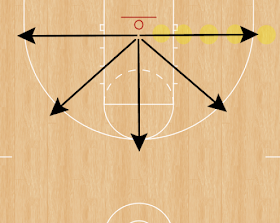Garden Party
I went to a garden party to reminisce with my old friends
A chance to share old memories and play our songs again
When i got to the garden party, they all knew my name
No one recognized me, i didn't look the same
A chance to share old memories and play our songs again
When i got to the garden party, they all knew my name
No one recognized me, i didn't look the same
But it's all right now, i learned my lesson well.
You see, ya can't please everyone, so ya got to please yourself
You see, ya can't please everyone, so ya got to please yourself
Tryouts are on the horizon. What are we looking for? What is the ultimate goal? What 'confounding factors' exist (push back)?
The search. This isn't America's Got Talent. Nobody wins a million bucks. I'm not a System Coach, so I'm not focused on the tallest, the quickest, who will 'fit in'. Dean Smith said, "I don't coach effort, I coach execution." Effort (especially at tryouts) is a given. Sometimes, I'll do a test, "I need a volunteer." Back in the day, by the time I heard "I need a", I'm already up. I don't care if it's a volunteer to pick up trash. Coaches see that. Does a player make eye contact? I had a player awhile back who was the best sixth grader I've ever seen at making eye contact. I know she will succeed in life.
There's a balance between seeking more skill and more potential (that elusive combination of size, quickness, and athleticism that we believe we can use our alchemy to create skill).
At tryouts, I run players through 'drills and activities' that measure proficiency and potential at what we do. Can they learn a drill "on the fly"? Can they pay attention? We'll do Shivek "pass and cut"" drills (Israeli National Team), 3 line pick and roll options and 4 minute shooting (UCONN), and 4 on 4 halfcourt no-dribble (Indiana) scrimmaging among others. How well do you 'see' the game?
I'm not interested in watching three-man weave or cone drills. I'm confident we can beat a team of cones already...on most days.
Carl Pierson (The Politics of Coaching) does quantitative metrics including speed testing, jump testing, and weight lifting. "Why didn't my daughter make the team?" "She's a great kid, but aside from limited basketball skills, she was last of forty girls in each athletic measurement." "Oh."
The goal. Believe it or not, there is a state Middle School Championship. I...don't...care. I don't take a salary (there is one available) and I can't lose my mind over whether early teen girls win or lose a basketball game. The bigger fish to fry are learning teamwork, collaboration, leadership, problem solving, persistence and all those values that drive successful adults. The lessons from sports should translate to the classroom and the boardroom. And yes, that means learning to overcome biases and selfishness and already baked in bad habits. It means embracing work and change. It means teaching better listening skills, better learning skills, and improving communication skills (nonverbal and verbal).
Under the best circumstances, there would be coordination with the high school program.
Push back. Families pay to play, the money going for gym time, officiating, and to a lesser extent (they're in eighth grade now) equipment. The Rec Department obviously benefits from more participants. An extra couple of players brings in 800-1000 dollars. If you multiply that by four grades, boys and girls, the dollars start to add up. I understand that parents want more 'minutes' for Susie. That argues for fewer players. Parents of children at the margin of making the team presumably want more players. Some coaches argue "you should only have ten players", more development. I'd argue that I want to give more players a chance to develop.
I fall back to watching a friend (and high school teammate) play on the "Freshman B" team in high school. He later outplayed a future Boston Celtics draft choice in Boston Garden in the State Tournament. An outstanding student and person, he earned a scholarship to Tufts and became an executive for Fluor Corporation. That's applied learning.
Pete Newell argued that balance is an important part of the game. I agree. That means life balance as well as balance on the court. "Ya got to please yourself."



























